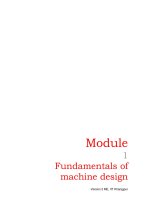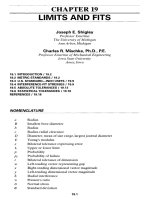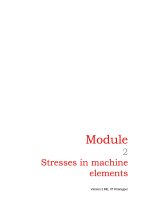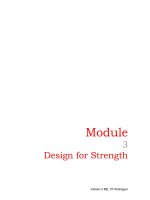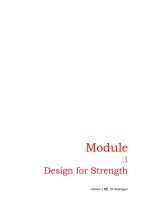Tài liệu Fundamentals of Machine Design P4 pdf
Bạn đang xem bản rút gọn của tài liệu. Xem và tải ngay bản đầy đủ của tài liệu tại đây (602.71 KB, 25 trang )
Version 2 ME, IIT Kharagpur
Module
2
Stresses in machine
elements
Version 2 ME, IIT Kharagpur
Lesson
1
Simple stresses
Version 2 ME, IIT Kharagpur
Instructional Objectives
At the end of this lesson, the student should have adequate knowledge of
• Simple stresses in machine elements; tensile, compressive, bearing and
shear stresses.
• Flexture formula and their limitations.
• Torsion formula and its limitations.
• Design of members subjected to combined bending, torsion and axial loading.
• Buckling of beams.
2.1.1 Introduction
Stresses are developed in machine elements due to applied load and
machine design involves ensuring that the elements can sustain the induced
stresses without yielding. Consider a simple lever as shown in figure-2.1.1.1:
2.1.1.1F- A simple lever subjected to forces at the ends.
A proper design of the spring would ensure the necessary force P at the lever
end B. The stresses developed in sections AB and AC would decide the optimum
cross-section of the lever provided that the material has been chosen correctly.
A
F
Spring
Stiffness
K
P
Hinge Pin
B
C
Version 2 ME, IIT Kharagpur
The design of the hinge depends on the stresses developed due to the reaction
forces at A. A closer look at the arrangement would reveal that the following
types of stresses are developed in different elements:
Lever arms AB and AC - Bending stresses
Hinge pin - Shear and bearing stresses.
Spring - Shear stress.
It is therefore important to understand the implications of these and other simple
stresses. Although it is more fundamental to consider the state of stress at a
point and stress distribution, in elementary design analysis simple average
stresses at critical cross-sections are considered to be sufficient. More
fundamental issues of stress distribution in design analysis will be discussed later
in this lecture.
2.1.2 Some basic issues of simple stresses
Tensile stress
The stress developed in the bar ( figure-2.1.2.1) subjected to tensile loading is
given by
2.1.2.1F- A prismatic bar subjected to tensile loading.
Compressive stress
The stress developed in the bar ( figure-2.1.2.2) subjected to compressive
loading is given by
P
P
A
t
P
A
σ=
c
P
A
σ =
Version 2 ME, IIT Kharagpur
2.1.2.2F- A prismatic bar subjected to compressive loading.
Here the force P is the resultant force acting normal to the cross-section A.
However, if we consider the stresses on an inclined cross-section B ( figure-
2.1.2.3) then the normal stress perpendicular to the section is
and shear stress parallel to the section
2.1.2.3F- Stresses developed at an inclined section of a bar subjected to tensile
loading.
P
P
A
σ
θ
τ
θ
PP
B
Pcos
A/cos
θ
θ
σ=
θ
Psin
A/cos
θ
=
θ
τ
Version 2 ME, IIT Kharagpur
Bearing stress
When a body is pressed against another, the compressive stress developed is
termed bearing stress. For example, bearing stress developed at the contact
between a pillar and ground (figure- 2.1.2.4a) is , at the contact
surface between a pin and a member with a circular hole (figure- 2.1.2.4b)
is and at the faces of a rectangular key fixing a gear hub on a shaft
(figure- 2.1.2.4c) is .
(a) (b) (c)
2.1.2.4F- The bearing stresses developed in pillar and machine parts.
The pressure developed may be irregular in the above examples but the
expressions give the average values of the stresses.
Shear stress
When forces are transmitted from one part of a body to other, the stresses
developed in a plane parallel to the applied force are the shear stresses ( figure-
2.1.2.5) and the average values of the shear stresses are given by
in single shear
in double shear
P
A
Pillar
Area of
cross-section
L
Diameter, D
P
br
P
A
σ =
br
P
Ld
σ=
br
4T
aLd
σ=
P
A
=
τ
P
2A
=
τ
L
T
d
a
a
Gear
Key
Shaft
Version 2 ME, IIT Kharagpur
.
2.1.2.5F- Stresses developed in single and double shear modes
In design problems, critical sections must be considered to find normal or shear
stresses. We consider a plate with holes under a tensile load (figure-2.1.2.6) to
explain the concept of critical sections.
2.1.2.6F- The concept of critical sections explained with the help of a loaded
plate with holes at selected locations.
Let the cross-sectional area of the plate, the larger hole H
1
and the smaller holes
H
2
be A, a
1,
a
2
respectively. If 2a
2
> a
1
the critical section in the above example is
CC and the average normal stress at the critical section is
P
P
2P
P
P
Shear area A
P
P
A
A
B
B
C
C
D
D
H
1
H
2
H
2
H
2
2
P
A2a
σ=
−
Version 2 ME, IIT Kharagpur
2.1.3 Bending of beams
2.1.3.1 Bending stresses
Consider two sections ab and cd in a beam subjected to a pure bending. Due to
bending the top layer is under compression and the bottom layer is under
tension. This is shown in figure-2.1.3.1.1. This means that in between the two
extreme layers there must be a layer which remains un-stretched and this layer is
known as neutral layer. Let this be denoted by NN
′
.
2.1.3.1.1F- Pure bending of beams
We consider that a plane section remains plane after bending- a basic
assumption in pure bending theory.
If the rotation of cd with respect to ab is d
φ
the contraction of a layer y distance
away from the neutral axis is given by ds=y d
φ
and original length of the layer is
x=R d
φ
, R being the radius of curvature of the beam. This gives the strain
ε
in the
layer as
M
M
a
bd
c
x
d
φ
N
N'
M
M
a'
b'
c'
d'
y
R
Version 2 ME, IIT Kharagpur
y
max
y
d
σ
=
σ
x
max
y
d
σ
=
σ
We also consider that the material obeys Hooke’s law
σ
= E
ε
. This is another
basic assumption in pure bending theory and substituting the expression for
ε
we
have
Consider now a small element dA y distance away from the neutral axis. This is
shown in the figure 2.1.3.1.2
2.1.3.1.2F- Bending stress developed at any cross-section
Axial force on the element dF
x
= and considering the linearity in stress
variation across the section
we have where
σ
x
and
σ
max
are the
stresses at distances y and d respectively from the neutral axis.
The axial force on the element is thus given by dF
x
max
y
dA
d
σ
=
.
For static equilibrium total force at any cross-section F=
This gives and since A
≠
0, .This means that the neutral axis
passes through the centroid.
Again for static equilibrium total moment about NA must the applied moment M.
This is given by
and this gives
A'
A
M
σ
max
d
d
x
y
M
M
A
NN'
A'
y
dA
Section AA'
y
R
ε =
E
y R
σ
=
x
dAσ
max
A
ydA 0
d
σ
=
∫
A
ydA yA 0==
∫
y0=
max
A
y
ydA M
d
σ
=
∫
max
Md
I
σ=
Version 2 ME, IIT Kharagpur
For any fibre at a distance of y from the centre line we may therefore write
We therefore have the general equation for pure bending as
2.1.3.2 Shear stress in bending
In an idealized situation of pure bending of beams, no shear stress occurs across
the section. However, in most realistic conditions shear stresses do occur in
beams under bending. This can be visualized if we consider the arguments
depicted in figure-2.1.3.2.1 and 2.1.3.2.2.
No change in bending moment Bending moment changes along
along the length. the length of the beam
2.1.3.2.1F- Bending of beams with a steady and varying moment along its length.
My
I
σ=
ME
y IR
σ
= =
M
M
M
1
M
2
A
BD
C
ANIMATE



